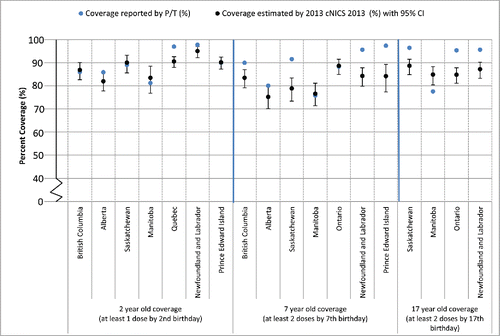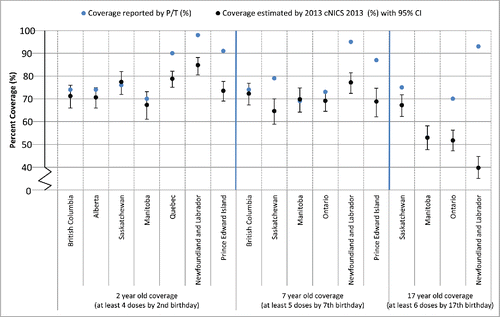Figures & data
Table 1. Methods used for immunization coverage assessment, by P/T.
Figure 1. Comparison of immunization coverage estimates reported by select Canadian Provinces and as estimated by the 2013 childhood National Immunization Coverage Survey (cNICS): Measles
Notes:
1. Two-year old immunization coverage data for the Regional Health Authority of Vancouver Coastal Health are not included within the provincial estimate because coverage for this region is assessed periodically using survey methods.
2. Coverage estimates for Saskatchewan are based on children who were registered in the Saskatchewan Immunization management System (SIMS) and with provincial health coverage at the time of assessment.
3. Manitoba coverage estimates can be found online: http://www.gov.mb.ca/health/publichealth/surveillance/mims/docs/2012.pdf.
4. The reference birth cohort used by Quebec is children born between Oct 1, 2011 and Dec 31, 2011 and evaluated at 24 months of age in 2014.
5. The birth year cohort for the assessment of 2-year-old measles coverage in PEI are those born within the province during the 2011/12 fiscal year.
6. Immunization coverage for measles at 7 years-of-age in British Columbia is derived from Panorama and the immunization registry in use in Vancouver Coastal Health (PARIS). In three regional health authorities, Ministry of Education data is used for denominator estimates.
7. The exception to Ontario's 'complete for age' coverage methodology is the ability to report on coverage for measles, mumps and rubella by number of doses. Two doses measles coverage estimates are presented for the birth cohorts of 1995 and 2005 who were 7 and 17 years of age in the 2012-13 school year, respectively.
8. The coverage definition used by PEI is the receipt of 2 doses of measles-containing vaccine by the 6th birthday.

Figure 2. Comparison of immunization coverage estimates reported by select Canadian Provinces and as estimated by the 2013 childhood National Immunization Coverage Survey (cNICS): Pertussis
Notes:
1. Two-year old immunization coverage data for the Regional Health Authority of Vancouver Coastal Health are not included within the provincial estimate because coverage for this region is assessed periodically using survey methods.
2. Manitoba coverage estimates can be found online: http://www.gov.mb.ca/health/publichealth/surveillance/mims/docs/2012.pdf
3. Quebec assessed coverage for children born between Oct 1 and Dec 31, 2011 using a coverage survey. The coverage definition used was receipt of at least 4 valid doses, with validity of doses assessed in relation to a minimum age at first dose and minimum intervals between doses.
4. The 2011-2012 fiscal year birth cohort was used in PEI and this only includes those born in PEI.
5. Immunization coverage for measles at 7 years-of-age in British Columbia is derived from Panorama and the immunization registry in use in Vancouver Coastal Health (PARIS). In three regional health authorities, Ministry of Education data is used for denominator estimates. Coverage is defined as 4th or 5th dose of diphtheria/acellular pertussis/tetanus and 3rd or 4th dose of polio after the fourth birthday and by the 7th birthday.
6. Ontario has historically calculated 'complete for age' coverage, which represents the proportion of students who are not yet 'overdue' for a particular immunization. For the cohort assessed, the pre-school booster was considered valid if given on or after the age of three years and nine months.
7. PEI assesses coverage by agent. Coverage among 7 year olds reflects administration of the Tdap-IPV pre-school booster administered between the ages of 4 and 6 years.
8. Ontario has historically calculated 'complete for age' coverage, which represents the proportion of students who are not yet 'overdue' for a particular immunization. For the cohort assessed, the pre-school booster was considered valid if given on or after the age of three years and nine months.

